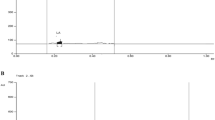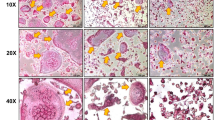Abstract
The aim of the study was to evaluate protective property of Lactobacillus casei and Lactobacillus acidophilus in minimizing oxidative stress associated with arthritis from liver and kidney. Subsequently, protective property of Lactobacillus against the bone damage was also taken into consideration. Arthritis was induced by injecting freund’s complete adjuvant (100 μl) into sub plantar surface of hind paw. Oral administration of culture, vehicle, and drug started after induction of arthritis (i.e. on day 9th). Indomethacin was used as a standard drug. Radiographic analysis of the hind paw knee joint was also done at the end of the 21st day. Oxidative stress parameters were studied from liver and kidney homogenate. Histopathology of liver and kidney was also performed. Lactobacillus treatment significantly rescued the enzymatic level of catalase, superoxide dismutase, reduced glutathione, and glutathione peroxidase in both liver and kidney homogenates, whereas it has decreased the malonaldehyde accumulation. Oral administration of Lactobacillus also significantly decreased the serum ceruloplasmin level. Radiographic analysis also corroborated these findings. Lactobacillus treatment maintained the normal histopathology of liver and kidney. Results of this study clearly suggest that L. casei and L. acidophilus, alone or in combination, decreased the bone damaged and effectively restored antioxidant status of liver and kidney. Lactobacillus has a significant antiarthritic and antioxidant activity against freund’s complete adjuvant induced arthritis in rats.









Similar content being viewed by others
References
Tripathi KD (2004) Essentials in medical pharmacology, 4th edn. J.B Medical Publishers, New Delhi
Patil KR, Patil CR, Jadhav RB, Mahajan VK, Patil PR, Gaikwad PS (2009) Anti-arthritic activity of Bartogenic acid isolated from fruits of Barringtonia racemosa Roxb. (Lecythidaceae). eCAM, 1–7
Bertolini A, Ottani A, Sandrini M (2001) Dual acting anti-inflammatory drugs: a reappraisal. Pharmacol Res 44:437–450
White WB, West CR, Borer JS, Gorelick PB, Lavange L, Pan SX et al (2007) Risk of cardiovascular events in patients receiving celecoxib: a meta-analysis of randomized clinical trials. Am J Cardiol 99:91–98
Singh G, Triadafilopoulos G (1999) Epidemiology of NSAID induced gastrointestinal complications. J Rheumatol 56:18–24
Galati GS, Tafazoli O, Sabzevari TM, Chan TS, O’Brien PJ (2002) Idiosyncratic NSAID drug induced oxidative stress. Chem Biol Interact 142:25–41
Hitchon CA, Ei-Gabalawy HS (2004) Oxidation in rheumatoid arthritis. Arthritis Res Ther 6(6):265–278
Gutteridge A (1986) Study of their activity in serum and synovial fluid from patients with rheumatoid arthritis. Biochem Biophys Acta 869:119–127
Beimond P, Swakk AK, Koster JF (1984) Protective factors against oxygen free radicals and hydrogen peroxide in rheumatoid arthritis synovial fluid. Arth Rheumatol 27:760–765
Yu BP (1994) Cellular defences against damage from reactive oxygen species. Biol Rev 74:139–162
Ray G, Husain SH (2002) Oxidants, antioxidants and carcinogenesis. Ind J Exp Biol 40:1213–1232
Hadjigogos K (2003) The role of free radicals in the pathogenesis of rheumatoid arthritis. Panminerva Med 45:7–13
Akkus I, Kalak S, Vural H, Caglayan O, Menekse E, Can G, Durmus B (1996) Leukocyte lipid peroxidation, superoxide dismutase, glutathione peroxidase and serum and leukocyte vitamin C levels of patients with type II diabetes mellitus. Clin Chim Acta 244:221–227
Taysi S, Gul M, Sari RA, Akçay F, Bakan N (2002) Oxidant/Antioxidant status in serum of patients with systemic lupus erythematosus. Clin Chem Lab Med 40:684–688
Taysi S, Kocer I, Memisoullari R, Kiziltunc A (2002) Oxidant/antioxidant status in serum of patients with Behçet’s disease. Ann Clin Lab Sci 32:377–382
Taysi S, Polat F, Gul M, Sari RA, Bakan E (2002) Lipid peroxidation, some extracellular antioxidants and antioxidant enzymes in serum of patients with rheumatoid arthritis. Rheumat Int 21:200–204
Yagi K (1984) Increased lipid peroxides initiates atherogenesis. Bio Essays 1:58–60
Whitehouse MW, Turner AG, Davis CKG, Roberts MS (2007) Emu oil(s): a source of non-toxic transdermal anti-inflammatory agents in aboriginal medicine. Inflammopharmacology 6(1):1–18
Kumar N, Singh S, Patro N, Patro I (2009) Evaluation of protective efficacy of Spirulina platensis against collagen-induced arthritis in rats. Inflammopharmacology 17:181–190
Bahrav E, Mor F, Halpam M, Weinberger A (2004) Lactobacillus GG bacteria ameliorate arthritis in lewis rats. J Nutr 134:1964–1969
Baken KA, Ezendam J, Gremmer ER, Klerk A, Pennings JLA, Matthee B, Peijnenburg AA, Loveren H (2006) Evaluation of immunomodulation by Lactobacillus casei Shirota: immune function, autoimmunity and gene expression. Int J Food Microbiol 112:8–18
Amdekar S, Singh V, Singh R, Sharma P, Yadav S, Kumar A (2010) Assessment of antiarthritic and immunomodulatory activity of Lactobacillus casei in collagen induced arthritis (CIA) experimental model. Int J Intergrative Biol 9(3):141–147
Amdekar S, Singh V, Singh R, Sharma P, Keshav P, Kumar A (2011) Lactobacillus casei reduces the inflammatory joint damage associated with collagen induced arthritis (CIA) by reducing the Pro-inflammatory cytokines. J Clin Immunol 30(6):147–154
Jarvenappa S, Thavonene RL, Ouwehand AC, Sandell M, Jarvenappa E, Salminene SA (2007) Probiotic Lactobacillus fermentum ME-3, has antioxidant capacity in cheese spread with different fats. J Dairy Sci 90:3171–3177
Kapila S, Vibha Sinha PR (2008) Antioxidative and hypocholestreolomic effect of Lactobacillus casei ssp. casei (Biodefensive properties of Lactobacilli). Ind J Med Sci 60(9):361–370
Pearson CM (1956) Development of arthritis, periarthritis, periostitis in give rat adjuvant. Proc Soc Exp Biol Med 91:95–105
Hoffman JC, Herkoltz C, Zeilder H, Bayer B, Rosenthal H, Westermann J (1997) Initiation and perpetuation of rat adjuvant arthritis is inhibited by the anti CD-2 monoclonal antibody (mAB) OX34. Ann Rheum Dis 56:716–722
Ellman GL (1959) Tissue sulfhydryl groups. Arch Biochem Biophys 82:70–77
Sinha AK (1972) Colorimetric assay of catalase. Ann Biochem 47:389–394
Winterbourn Barnaby RJ, Kent PW, Mian N (1979) Incorporation of N-fluoroacetyl-d-glucosamine into hyaluronate by rabbit tracheal explants in organ culture. Biochem J 182:707–716
Ohkawa H, Ohishi N, Yagi K (1979) Assay for lipid peroxides in animal tissue by thiobarbituric reaction. Ann Biochem 95:351–358
Flohe L, Gunzler WA (1984) Assays of glutathione peroxidase. Meth Enzymol 105:114–121
Prakash M, Shetty JK (2008) A modified spectrophotometric micromethod to determine serum copper. Asian J Biochem 3(1):38–42
Silva AM, Bambirra EA, Oliveira AL, Souza PP, Gomes DA, Vieira EC, Nicoli JR (1998) Protective effect of Bifidus milk on the experimental infection with Salmonella enteritidis subsp. typhimurium in conventional and gnotobiotic mice. J App Microbiol 86:331–336
Aota S, Nakamura T, Suzuki Y, Tanaka Y, Okazaki Y, Segawa Y, Miura M, Kikuchi S (1996) Effects of indomethacin administration on bone turnover and bone mass in adjuvant-induced arthritis in rats. Cal Tissue Int 59:385–391
Makinen HH, Kautiainen P, Hanonen T, Hannone M, Leirisalo-Repo L, Laasonen M, Korpela H, Blafield H, Hakola M, Sokka T (2007) Sustained remission and reduced radiographic progression with combination diseases modifying antirheumatic drugs in early rheumatoid arthritis. J Rheumatol 34:316–321
Calvin M, Gorzalczany S, Macho A, Munoz E, Ferraro G, Acevedo C et al (2007) Anti-inflammatory activity of flavonoids from Eupatorium arnottianum. J Ethnopharmacol 16:585–589
Sabina EP, Rasool M (2007) Therapeutic efficacy of Indian ayurvedic herbal formulation Triphala on lipid peroxidation, antioxidant status and inflammatory mediators TNF-α in adjuvant induced arthritis mice. Int J Biol Chem 1(3):149–155
Geetha T, Varalkshmi P, Marylatha R (1998) Effect of triterpens from Crataeva nurvala stem bark on lipid peroxidation in adjuvant induced arthritis in rats. Pharmacol Res 37(3):191–195
Rasool M, Varalakhsmi P (2007) Protective effect of Whithania somnifera root powder in relation to lipid peroxidation, antioxidant status, glycoproteins and bone collagen on adjuvant-induced arthritis. Fund Clin Pharmacol 21:157–164
Ostrakhovitch EA, Afanas’ev IB (2001) Oxidative stress in rheumatoid arthritis leukocytes: suppression by rutin and other antioxidants and chelators. Biochem Pharmacol 62(6):743–746
Ramprasad VRP, Shanti P, Sachdanandam P (2005) Evaluation of antioxidant effects of Semecarpus anacardium Linn. Nut extract on the components of immune system in adjuvants arthritis. Vas Pharmacol 42:179–186
McCord JM, Boyle JA, Day ED, Rizzolo LJ, Salin ML (1977) A manganese-containing superoxide dismutase from human liver. In: Michelson AM, McCord JM, Fridovich I (eds), Superoxides and superoxides dismutases. Academic Press, London, pp. 129–138
Roos D, Weening RS (1978) Defects in the oxidative killing of microorganisms by phagocytic leukocytes. Ciba Found Symp 65:225–262
Punitha ISR, Rajendran K, Shirwaikar A (2005) Alcoholic stem extract of Coscinium fenestratum regulates carbohydrate metabolism and improves antioxidant status in streptozotocin–nicotinamide induced diabetic rats. eCAM 2(3):375–381
Govindarajan R, Vijaykumar M, Shirwaikar A, Rawat AKS, Mehrotra S, Pushpangadan P (2006) Antioxidant activity of Desmodium gangetium and its phenolics in arthritic rats. Acta Pharmaceutical 56:489–496
Rister M, Bancher RL (1976) The alteration of SOD, CAT, GPx, NADPH, Cyt: C, Oxidase in guinea pig polymorhonuclear leucocytes and alveolar macrophage during hypoxia. J Clin Inv 58:1174–1184
Paval J, Kaitheri SK, Potu BK, Govindan S, Kumar RS, Narayan SN, Moorkoth S (2009) Comparing the anti-arthritic activities of the plants Justica gendarussa Burm F. and Withania somnifera Linn. Int J Green Pharm 3:281–284
Lotz M (1999) The role of nitric oxide in articular cartilage damage. Rheum Dis Clinics North Am 25:269–282
Tiku ML, Gupta S, Deshmukh DR (1999) Aggrecan degradation in chondrocytes is mediated by reactive oxygen species and protected by antioxidants. Free Radical Res 30:395–405
Filippin LI, Vercelino R, Marroni NP, Xavier RM (2008) Redox signaling and the inflammatory response in rheumatoid arthritis. Clin Exp Immunol 152:415–422
Kojima H, Uemura M, Sakurai S (2002) Clinical features of liver disturbance in rheumatoid diseases: clinicopathological study with special reference to the cause of liver disturbance. Gastroenterology 37:617–625
Acknowledgments
The author would like to thank the Institute of Biomedical Sciences, Bundelkhand University, Jhansi, Uttar Pradesh, for Animal House and laboratory facility and the Department of Microbiology, Barkatullah University, Bhopal, for laboratory facility provided to conduct the study.
Conflict of interest
There are no financial competing interests (political, personal, religious, ideological, academic, intellectual, commercial, or any other) to declare in relation to this manuscript.
Author information
Authors and Affiliations
Corresponding author
Rights and permissions
About this article
Cite this article
Amdekar, S., Kumar, A., Sharma, P. et al. Lactobacillus protected bone damage and maintained the antioxidant status of liver and kidney homogenates in female wistar rats. Mol Cell Biochem 368, 155–165 (2012). https://doi.org/10.1007/s11010-012-1354-3
Received:
Accepted:
Published:
Issue Date:
DOI: https://doi.org/10.1007/s11010-012-1354-3




